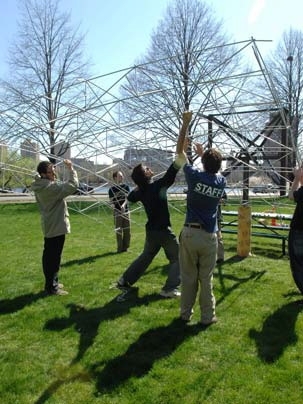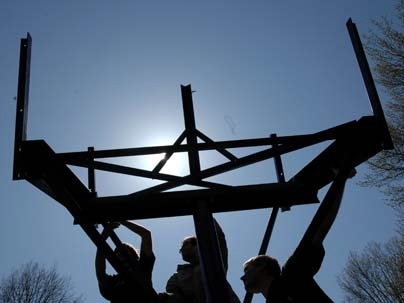For a project that could be on the very cutting edge of renewable energy, this one is actually decidedly low tech--and that's the point.
A team of students, led by mechanical engineering graduate student Spencer Ahrens, has spent the last few months assembling a prototype for a concentrating solar power system they think could revolutionize the field. It's a 12-foot-square mirrored dish capable of concentrating sunlight by a factor of 1,000, built from simple, inexpensive industrial materials selected for price, durability and ease of assembly rather than for optimum performance.
Rather than aiming for a smooth parabolic surface that would bring the sunlight to a perfect focus, the dish is being made with 10-inch-wide by 12-foot-long strips of relatively low-cost, lightweight bathroom-type mirror glass. The frame is assembled from cheap aluminum tubing, with holes drilled in precise locations using a simple jig for alignment, so that the struts can be assembled into a framework that passively snaps into just the right parabolic curvature.
The control mechanism, which allows the dish to track the sun automatically across the sky, is also remarkably simple--photocells mounted on each side of the dish with opaque baffles, which cast a shadow on the cell when it drifts out of alignment, connect to a simple circuit that turns on small electric motors to push the dish back into the right position.
"The technical challenge here is to make it simple," Ahrens explains. The team is keeping careful track of all the costs for parts and the time spent on assembly, to provide a baseline for figuring out what an eventual large-scale field of such dishes would cost. "We're using all commodity materials that are all in high production," he says.
That's in stark contrast to most attempts to build solar dish concentrating systems, which have tended to use expensive custom-made equipment to achieve high efficiency. A few large companies that have built such prototypes tend to "turn it into an ultimate high-tech, high-end project," says Jefferson Tester, HP Meissner Professor of Chemical Engineering, who has been advising the student-led group. "Then Spencer came along and said, 'We're going to fundamentally change this and make this an affordable technology for popular, widespread deployment.'"
Ahrens thinks that in mass production the dishes can be competitive in cost with other energy sources and could produce heat for space heating and electric power at the same time.
The prototype isn't quite finished yet, because of delays in getting the mirror glass shipped from the factory. And the details of assembly and operation could well present some unexpected stumbling blocks, as is so often the case with new designs, Tester says. Still, "they're smart kids, they know what they're doing," he says. "That's how you learn."
This is not the kind of thing you'd build for a single-home, backyard power system, however. Because the highly concentrated sunlight will be so powerful, the team is employing several precautions to safeguard against potential safety risks, and the prototype will not operate in public without supervision.
Instead, the systems are designed to be deployed in large, utility-scale fields, fenced in to protect anyone from being in the wrong place. But because the beam comes to a focus about 12 feet from the surface, the danger is strictly localized--no risks for adjacent buildings or for planes flying overhead, Ahrens explains. When not attended, the dish will be covered "parked" pointing straight up, and will be mounted 7 feet above ground.
The students working on the project, because of their close proximity, will have to take precautions, wearing all-white clothing, to reflect the light, and welder-type goggles to protect their eyes.
Ahrens believes that such a design could quickly produce both hot water for space heating and electricity for the grid at prices that would be competitive today, unlike conventional photovoltaic systems that are still far too pricey for baseload generation. "In the sunbelt, our dish would make about 10,000 peak watts of heat and 3,500 peak watts of electricity," he says. Deployed in large numbers, the systems could make a big difference: "One square meter of concentrator is worth about one barrel of oil per year," he says.
"It's designed for long life--we hope they will last more than 30 years with good maintenance--and for indigenous manufacturing in the developing world with minimal tooling," Ahrens says. "We want to get something up that will be kind of viral and be widely adopted around the world."
A version of this article appeared in MIT Tech Talk on May 7, 2008 (download PDF).






